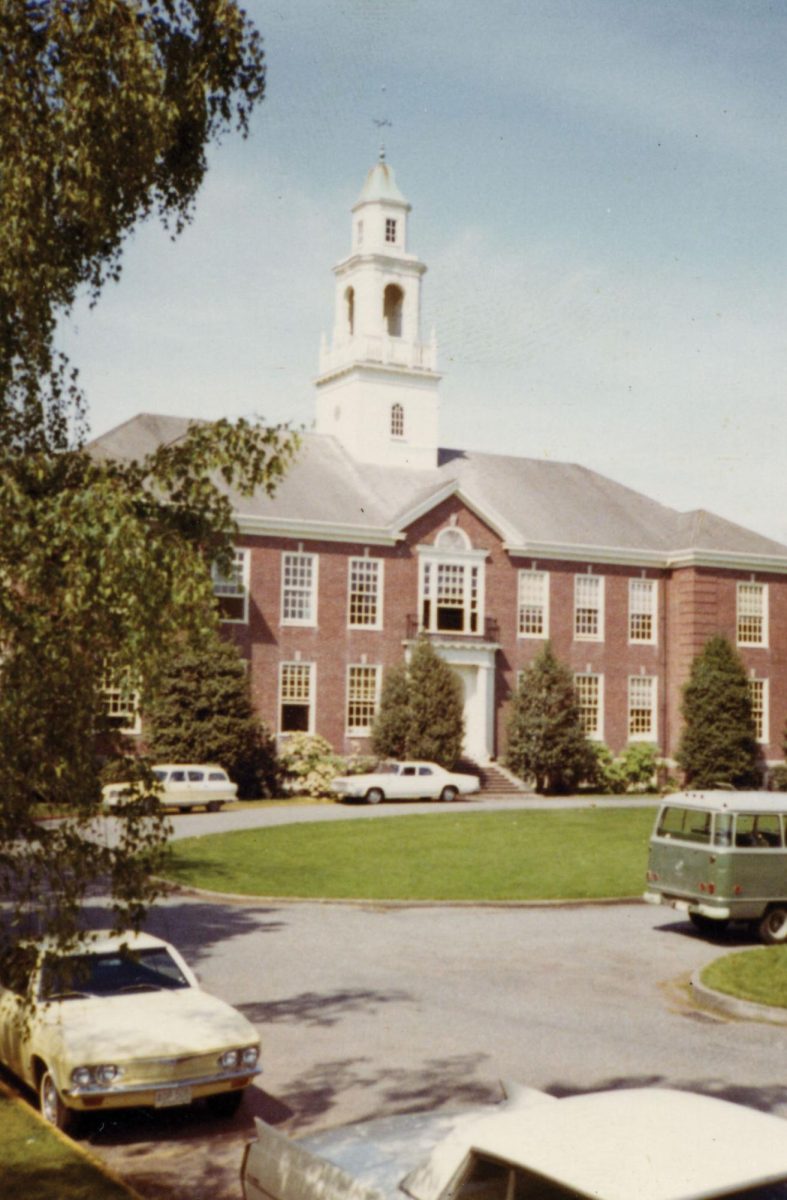Every day, hundreds of students enter through the double doors of one of Lakeside’s oldest buildings to attend various classes. When Bliss Hall was built nearly 100 years ago, it was the only classroom building on campus, including for lower school students, who had classes there until the 1960s. Today, Bliss is home to history and language classes, the college counseling center, and administrative offices. But from the day it opened its doors for the first time, Bliss Hall has been home to much more than just classrooms.
When Bliss Hall was built, the only other buildings on campus were Moore Hall, which was the dormitory, the headmaster’s house, and the gymnasium (which was torn down in 2013), so Bliss was the center of school activity. This included the library, the archives, and the art program.
Even Christmas celebrations, like the popular lower school Christmas plays with 100+ member audiences, happened in Bliss Hall when the school was Christian and all-boys. The main entrance was elaborately decorated with wreaths, and just inside, in front of the main office, a large tree was prominently placed with shiny ornaments. This wasn’t the only kind of holiday spirit, though. Thanksgiving celebrations, held by the upper school in the 1940s, didn’t include a play, but rather plenty of guns for anyone willing to give up 50 cents.
In 1935, the fourth floor of Bliss Hall was one of the “finest ranges in the city” (Tatler, Sept. 19, 1935). The Lakeside Rifle Club practiced there until the early 1950s. Every year, they would host a Thanksgiving Turkey Shoot. By the 1940s, Rifle Club members weren’t allowed to participate, but other students could pay to play for a chance to get the best score and win a whole 20-pound turkey. For anyone looking for a more serious commitment, the Rifle Club had guns for every student who wanted to join, provided they brought their own ammunition. Students could compete with other schools and earn qualifications with the National Rifle Association. In 1939, they were ranked among the top 15 rifle clubs in the nation and achieved second place west of the Mississippi, falling short only of the UW men’s team. Bliss Hall not only hosted the Rifle Club, but it was also the home base for everything from the News Club (early Tatler) to the Dramatic Club.
Another integral part of Bliss Hall’s history is the bell tower. The original beloved bronze bell, two feet in diameter, was cast in Cincinnati, Ohio and transported by a covered wagon to Washington in 1880. Lester Lewis, president of the Board of Trustees, purchased it from a secondhand store as a gift from the class of 1944. The bell was intended to be manually rung after sports victories, hence the name “The Victory Bell.” By 1948, this tradition was already forgotten, and it wasn’t long before students discovered how to sneak into the bell tower, covering the room with graffiti.
Thirty-one years later, digital chimes were installed to replace the bell. Every hour, they play the Westminster Quarters, which were originally written for Cambridge University’s church but popularized by Big Ben. There are four different chord progressions for each quarter of an hour, but Lakeside only plays the fourth quarter: four measures of song and one ring for every hour that has passed since noon or midnight, all ending 20 seconds before the hour actually changes. This wouldn’t have been possible with the real bell — the Westminster Quarters require at least four physical bells in order to play the four different pitches.
Not every song played in Bliss Hall was classical, and Lakeside was in the midst of a dance-related rebellion in the 2000s. The early years of the 21st century marked the rise of somewhat inappropriate dancing or “freak dancing” at Lakeside. Soon, parents and teachers were getting concerned, and 49% of the student population agreed they would rather attend a ballroom or square dance than go to one of Lakeside’s traditional upper school dances, given their current state. This led to a ban on “freak dancing” at dances in 2010, which was effective until someone realized they could dance however they wanted during the school day. Some couples danced privately, but others wanted to make a scene. And what better place to do it than the balcony of Bliss Hall? But just a year later, this dancing counterculture was widely forgotten, and the whole senior class danced together instead to celebrate renovations in Bliss Hall.
Bliss Hall’s long history defines the building as it is today. From a rifle club to the bell to freak dancing, Bliss Hall has always been an essential part of the upper school campus and remains a building with a long future ahead.”
Tatler extends a special thanks to Ms. Schuyler, the Lakeside archivist, for her assistance in researching this article.


